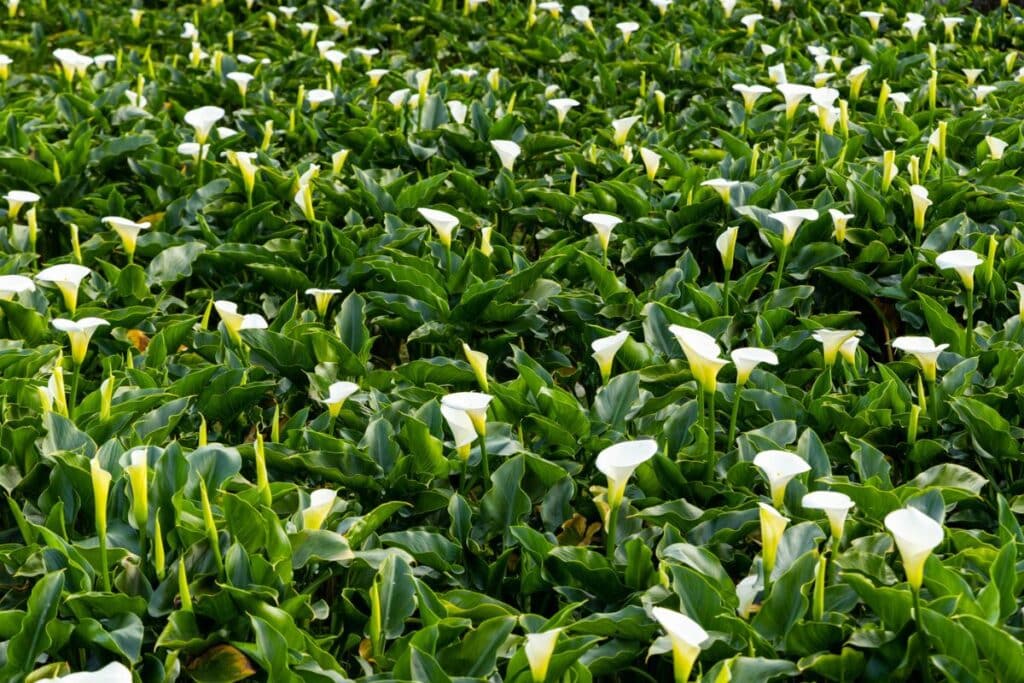Calla lilies (Zantedeschia) are favorites in ornamental gardens and are frequently used in flower arrangements or for wedding bouquets. There are many different varieties of this flowering plant and their colors range from white to dark maroon.
For companion planting with calla lilies, it is best to pair it with other beautiful species like marigolds, catmint, creeping jenny, lavender, roses, hostas, freesias or freesias that can complement the beautiful blooms or fill out your garden bed.
Let’s take a closer look at these calla lily companions and explore some creative ways to use them in your landscapes.
What to Grow with Calla Lilies
If you want your calla lily plants and all of their companions to grow healthy and strong then it is best to combine plant species with similar growing conditions together.
Calla lilies are quite flexible because these bulbs can be grown in full sun or light shade positions. In cooler climates, it is best to position them in direct sun but in warmer regions, they should be placed in partial shade or they can wilt.
When it comes to growing calla lilies, these flowers prefer well-drained soil with lots of organic matter and need to be watered regularly and will thrive in warmer climates.
Another important thing to keep in mind when you are doing companion planting is that these bulbs are perennial plants but will die back for the colder winter months.
Gardeners often combine them with evergreens to keep their beds full or with other bulbs so they can easily dig up all the bulbs before the ground freezes and keep them stored for the winter.
Let’s take a look at some companion plants that have similar growing requirements or plant species that can complement and enhance these beautiful flowers.
Marigolds
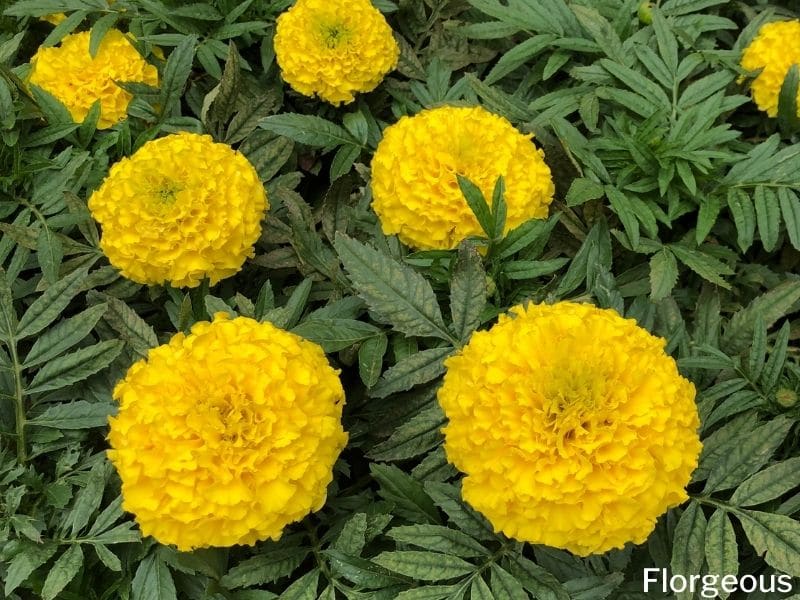
Marigold flowers (Tagetes), also known as African marigolds, Aztec marigolds, or American marigolds are charming companions for a sunny spot in your garden.
The bright yellow and orange flowers of this plant will also complement your beautiful calla lily blooms and marigolds have pest-repelling properties that can protect your bulbs from pests or fungal diseases.
These calla lily companion plants grow their absolute best if they are placed in full sun and can tolerate extreme heat. These hardy flowers can tolerate moist conditions but won’t grow well in moist soil in shaded areas.
You can mix calla lilies and marigolds all over your garden bed because these plants have a similar height. Together, they will add lots of texture and color and both are cut flowers that can be used to create beautiful indoor flower arrangements.
Lavender
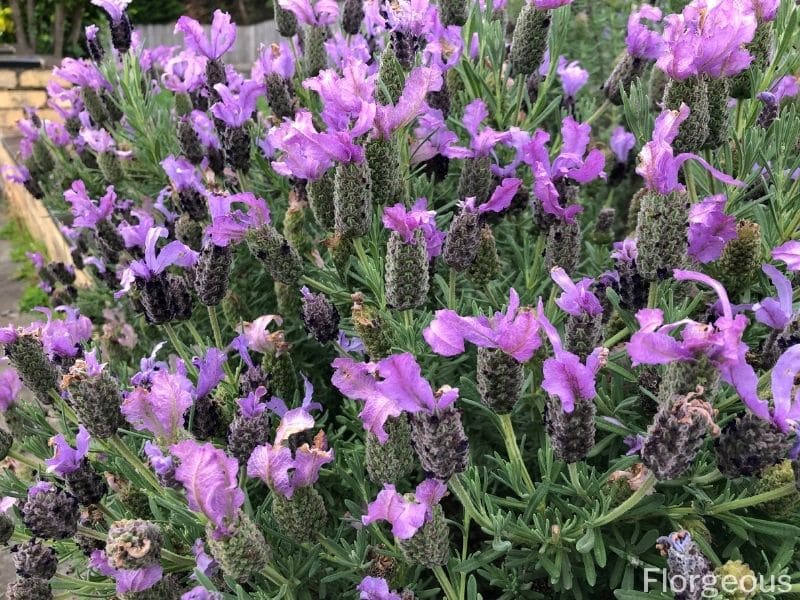
Lavender (Lavandula) is another great companion plant if you need something for a sunny location in your garden.
These herbaceous plants produce fragrant lavender blue flowers on tall spikes that can add lots of texture and color to your garden bed. These slender stems with blooms will look striking alongside bright-colored calla lilies.
Gardeners love to include these perennial species in calla beds because they are evergreen and will keep your garden lush and full when your lilies die back for winter. In harsh winters, these flowers can however struggle because they prefer warmer climates.
Lavender is drought tolerant and should be planted in full sun or it won’t produce as many blooms. The plants should als be grown in free-drained soil or they can start to develop root rot.
You can mix calla lilies and lavender plants all over your garden bed. The lilies will look striking as they peek out from behind or beside the vivid purple flowers and both species are ideal for creating a striking cutting garden.
Roses
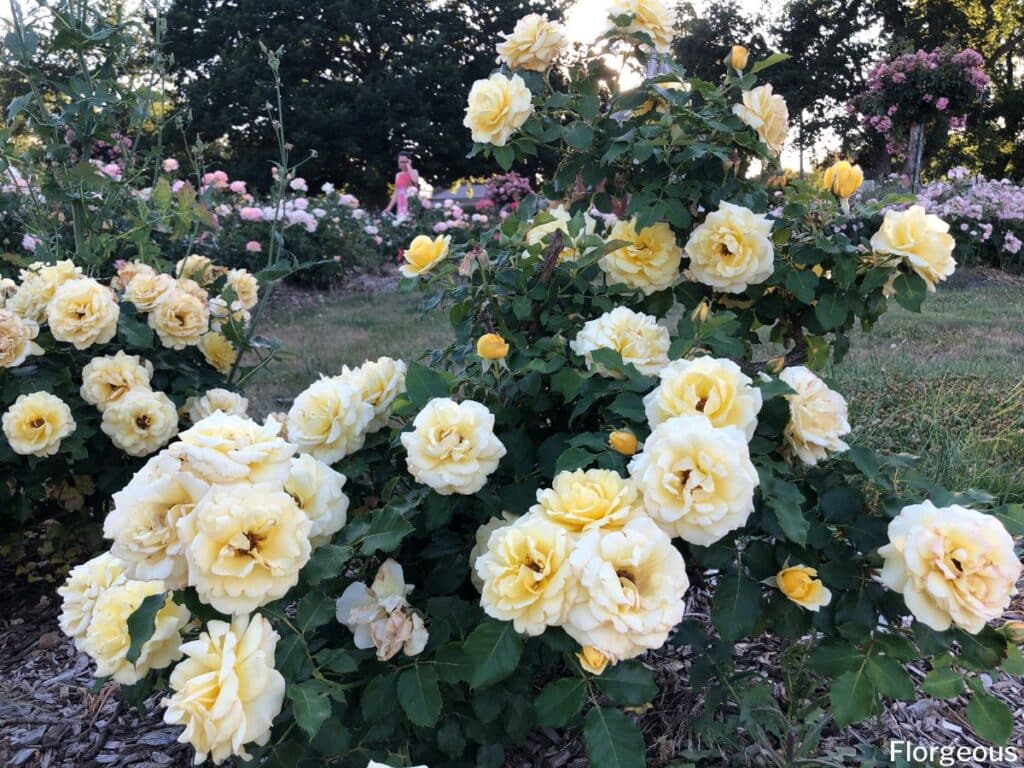
You can also combine your calla lily bulbs with Roses (Rosa). Gardeners often grow evergreen roses because they are great for keeping your garden full during the colder months.
These evergreen species will also produce gorgeous flowers from late spring to early fall and can look striking behind or next to the vivid calla lily flowers.
Roses love plenty of direct sunlight and should be placed where they will receive at least 6 hours of direct sun per day or they won’t bloom. They should also be planted in free-draining soil that has lots of organic matter and needs to be watered regularly, especially in dry and hot climates.
There are 360 different species of roses which include miniatures, ground covers, shrubs, and vine varieties.
Shrub and vine varieties can be good companions because they will create plenty of shade for your calla lilies but you can also combine miniature species in the same garden to create a full bed.
Hostas
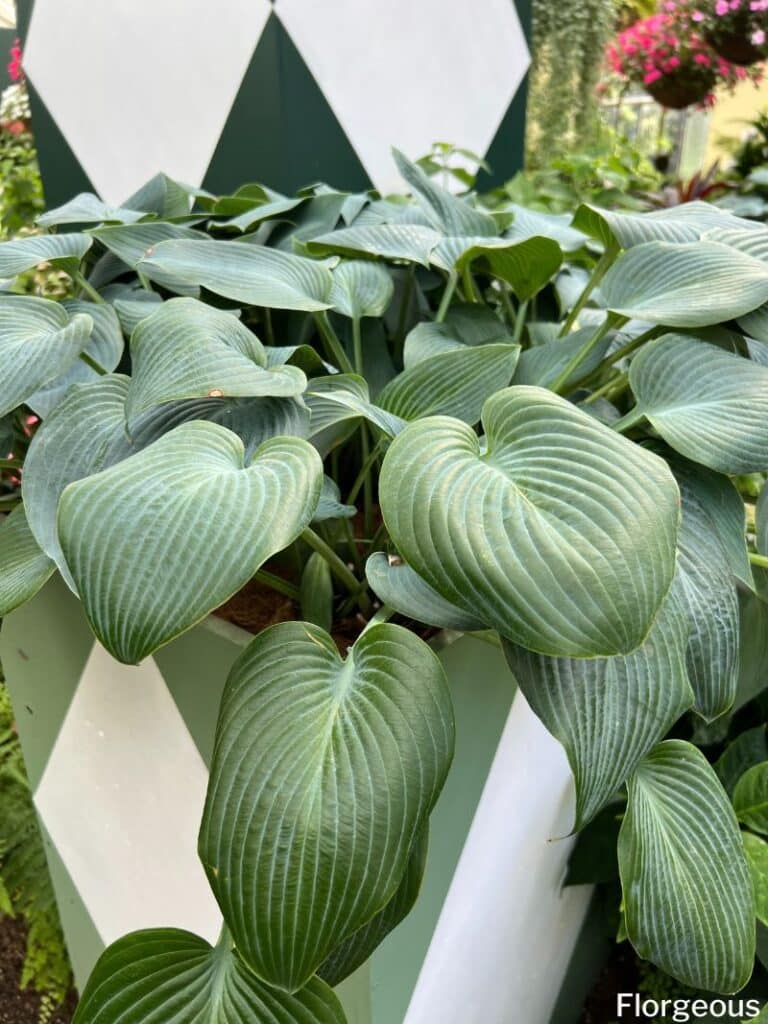
Hostas (Hosta), also known as plantain lilies, are wonderful evergreen perennials if you want to keep your garden full throughout the year.
These plants produce leaves that look quite similar to the leaf patterns of calla lilies but they grow vigorously and will spread all over your garden bed to create a lush effect. The calla lily flowers will look quite striking if they stand out tall in front of mass-planted hostas.
You can plant hostas in shaded areas or light to deep shade areas. They also love moist soil and can grow well in humid conditions.
It is best to select hosta varieties with lighter leaf colors because these varieties grow very well in the light or dappled shade that calla lilies require. For optimal results, you can try combining bunches of hostas and calla lilies to create showy hedges or borders.
Freesias
Freesia plants (Freesia), also known as baboon flowers, can add a lot of interest and color to your garden with their beautiful bell-shaped flowers.
These are good companions to consider if you want to include other bulb species in your beds and they are excellent for adding multiseasonal interest because they bloom from late winter to early spring.
There are many different flowering species with a wide array of colors that range from white to deep purple.
Freesias grow well in full sun or light shade and they should be established in moist soil that drains well.
You can combine different colors of freesias in your garden beds but remember that they won’t flower at the same time as your calla lilies.
Catmint
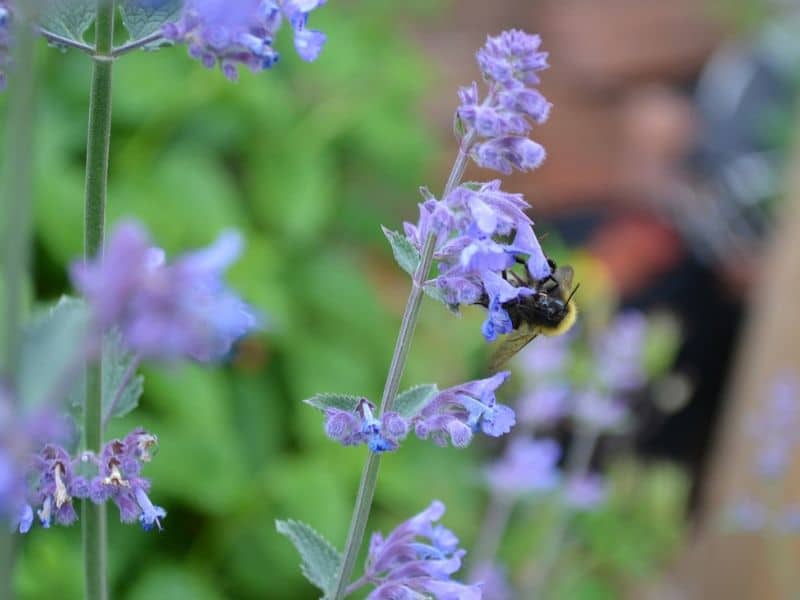
Catmint plants (Nepeta cataria), also known as catnip, catswort, or catwort, can look charming next to calla lilies.
This shrub will look especially striking if you combine it with white or yellow calla lilies because the purple and yellow flowers will create lots of contrast in your garden.
Catnip can grow in light shade but won’t flower properly in these conditions.
For vivid purple blooms, it is best to establish it in full sun in free-draining soil. These plants are quite drought tolerant and shouldn’t be watered too often or they can develop root rot.
It is best to establish these lovely shrubs behind your calla lilies because they can grow quite bushy.
Behind the vivid yellow and white flowers, they will create a perfect purple or light green backdrop that can enhance the appearance of your calla lilies.
Related: Catnip Companion Plants
Creeping Jenny
Creeping jennys (Lysimachia nummularia), also known as moneywort, herb twopence, or twopenny grass is a lovely addition for containers and hanging baskets.
This trailing plant will create a spiller effect over the edge of your containers and will add lots of color to your garden with its vivid lime-green leaves.
These are great companion plants for light shade areas in your garden or for patios. The plants love lots of moisture and shouldn’t be placed in direct sun or they can become scorched.
You can also use creeping jennies as a ground cover in your garden bed. These ground covers will keep the lily bulbs cool on those warm days and will form a striking backdrop for the vivid flowers.
What NOT to Grow with Calla Lillies
When you plant calla lily flowers in deep shade, they won’t produce any flowers and can even die out. Because of their need for partial shade, it is best not to grow them underneath tall trees that have a thick canopy.
These bulb flowers will become dormant during wintertime. If you live in cold areas then you should avoid planting them with perennials that have a shallow root system because this will make it very difficult to extract and store the bulbs for winter.
Landscaping Ideas for Calla Lilies and Companions
There are lots of great ways to use calla lilies along with their companion plants to create showy garden spaces.
Let’s take a look at a couple of creative landscaping ideas for your calla lilies and companions.
Indoor Arrangements
Calla lilies can be good indoor plants as long as you place them where they will receive plenty of indirect light.
You can combine them with other indoor plants like creeping jennies for a more showy effect on patios or interior spaces like kitchens or living rooms.
Mixed Containers
The calla lily will grow very well in containers. You can also include other plants alongside these flowers in the same garden pots to create a more interesting effect.
These flowers will look charming if you pair them with a filler plant like catnip and a spiller plant like creeping jenny.
Mixed Hedges or Borders
You can pair calla lily flowers with other plants like lavender, catnip, or hostas to create showy borders alongside walkways, in front of your garden wall, or next to your home wall.
The mixture of color and foliage will help accentuate walkways and can conceal those empty spaces around the base of fences or walls.
Cutting Gardens
Cutting gardens are very popular at the moment because they allow you to grow your own cut flowers that you can use in indoor flower arrangements.
For striking cut gardens, it is best to include a variety of flowering plants like calla lilies, lavender, marigolds, roses, and catnip. This variety will allow you to create all sorts of color combinations.
Final Thoughts
Calla lilies can be planted with a huge variety of companion species like catmint, roses, hostas, creeping jennies, marigolds, lavender, hostas, roses, and freesias. These ornamental plants will add lots of color and charm to your garden beds and are great for creating multi seasonal interest.
We hope that our guide helped you find some great companion plants to include in your garden bed and that you managed to get some inspiration for your own beautiful landscapes.
Learn more about calla lily symbolism to understand why people love growing this plant!
Up next: Calla Lily Leaves Turning Yellow? Causes and Effective Remedies
*image by leungchopan/depositphotos

